
How to Build a Strong Bond with Your Pet
Building a strong bond with your pet requires love, patience, and consistency. Activities like playtime, training, cuddles, and understanding their needs strengthen emotional connection. Using positive reinforcement, respecting boundaries, and communicating clearly make your pet feel secure and valued. A strong human-animal bond not only leads to better behavior but also brings lifelong companionship, joy, and trust between you and your furry friend.
🐶 Pet Star
38 min read · 17, Jul 2025

Introduction
Whether you have a dog, cat, rabbit, bird, or even a hamster—your pet is more than just an animal. They are a companion, a part of your daily life, and often a source of unconditional love. But just like any other relationship, building a deep and lasting bond with your pet takes time, effort, and understanding. A strong human-animal bond not only enhances your pet's emotional well-being but also makes them feel secure, happy, and more responsive to your care and affection.
In this article, we’ll explore the key elements of bonding with your pet, backed by behavioral science, along with practical tips you can use every day to strengthen your connection. Building a strong, enduring bond with your pet is a profound and rewarding journey that enriches both your life and theirs, transforming a simple cohabitation into a deep, mutual connection built on trust, understanding, and affection, a process that requires consistent effort, patience, and a genuine commitment to understanding and meeting your pet's unique physical, emotional, and psychological needs, recognizing that each animal, whether a dog, cat, bird, reptile, or small mammal, possesses its own distinct personality, communication style, and requirements for feeling secure and loved. The foundation of this bond is rooted in positive reinforcement, a method that involves rewarding desired behaviors rather than punishing unwanted ones, thereby teaching your pet what you want them to do in a way that is positive, fear-free, and strengthens their association of you with good things, whether that reward is a tasty treat, verbal praise, a favorite toy, or a gentle pet, this method builds confidence in your pet and fosters a willingness to engage and learn with you, avoiding the fear and anxiety that punitive methods can instill, which actively erodes trust and damages the bond. Beyond basic training, spending quality time together is paramount, moving beyond mere co-existence to active engagement; for dogs, this might mean regular walks that are more than just a potty break, but opportunities for exploration, sniffing, and engaging with the world, or dedicated play sessions involving fetch, tug-of-war, or puzzle toys that stimulate their minds, all of which are shared activities that create positive memories and associations with you; for cats, quality time often involves interactive play with wand toys that mimic prey, dedicated petting sessions if they enjoy physical affection, or simply quiet moments sharing a space, such as reading on the couch with them curled up beside you, as these moments, though seemingly small, accumulate to build a sense of companionship and comfort. Understanding your pet's unique communication signals is another critical pillar, as animals communicate through a complex array of body language, vocalizations, and behavioral cues that are often subtle but incredibly informative; learning to interpret a dog's tail wags, ear positions, and facial expressions, or a cat's purrs, meows, and slow blinks, allows you to respond appropriately to their needs and emotions, showing them that you hear and understand them, thereby deepening their trust in you as a reliable and attentive caregiver. This understanding also extends to recognizing signs of stress, fear, or discomfort, allowing you to intervene and provide reassurance, further solidifying your role as their protector and confidant.
Consistent routine and predictability also contribute significantly to a pet's sense of security and, consequently, their bond with you, as animals thrive on routine, which provides them with a sense of control and reduces anxiety about what comes next; predictable feeding times, regular exercise schedules, and consistent expectations around house rules create a stable environment where your pet feels safe and knows what to expect from you, fostering a sense of reliability and trust in your presence. This predictability helps to manage any separation anxiety or nervousness, as the pet learns that even when you leave, you will return within an expected timeframe. Furthermore, physical affection, when offered appropriately and respecting your pet's individual preferences, is a powerful bonding tool; for some dogs, this might mean belly rubs or enthusiastic scratches behind the ears, while for others, gentle petting on their favorite spot or simply leaning against you is preferred; for cats, a slow, deliberate approach, allowing them to initiate contact, and focusing on areas they enjoy (like under the chin or behind the ears) can strengthen the bond, ensuring that physical contact is always a positive experience rather than an imposition. It's crucial to pay attention to their reactions and stop if they show signs of discomfort or overstimulation. Shared experiences and novelty also play a role in deepening the bond, as introducing your pet to new, positive experiences, whether it's exploring a new walking trail, teaching them a new trick, or introducing them to a new, safe toy, can be incredibly enriching and strengthen your connection as you navigate these novel situations together, creating shared memories and reinforcing your role as their guide and companion in their world. This stimulation prevents boredom and keeps their minds active, further enhancing their well-being and engagement with you.
Moreover, meeting their species-specific needs is non-negotiable for a strong bond, recognizing that a dog's need for mental stimulation and exercise differs greatly from a cat's need for climbing structures and scratching posts, or a bird's need for social interaction and environmental enrichment; providing appropriate toys, a stimulating environment, and outlets for their natural behaviors demonstrates your understanding and respect for who they are as an animal, which directly contributes to their overall happiness and contentment, and consequently, their bond with you. This also includes providing high-quality nutrition, regular veterinary care, and a safe, comfortable living space. Addressing any behavioral challenges with patience, understanding, and professional guidance when needed, rather than frustration or punishment, is also key to preserving and strengthening the bond; issues like anxiety, aggression, or destructive behaviors often stem from unmet needs, fear, or lack of understanding, and by working through these challenges with positive, compassionate methods, you reinforce your pet's trust and demonstrate your commitment to their well-being, even when they are struggling. This commitment shows them they can rely on you, even when things are difficult. Finally, the simple act of talking to your pet, even if they don't understand the words, is incredibly beneficial; the tone of your voice, the rhythm of your speech, and the consistent sound of your presence can be incredibly soothing and reassuring to them, creating a continuous, gentle form of communication that reinforces your connection and constant presence in their lives, making them feel seen, heard, and deeply valued as a cherished member of your family, cementing a bond that is truly unique and irreplaceable.
Understanding the Human-Pet Bond
Before diving into how to build it, let’s understand what a “bond” with a pet truly means.
A strong bond includes:
- Mutual trust and comfort
- Consistent communication (verbal and non-verbal)
- Emotional attachment from both sides
- A sense of belonging and safety
This bond varies depending on the species and individual personality of your pet. For instance, dogs are naturally loyal and eager to please, while cats value independence but still crave affection. Rabbits, birds, or exotic pets also form attachments but may need more patience.
Why Bonding with Your Pet is Important
A deep pet-owner bond provides multiple benefits:
- Improved mental health for both pet and owner
- Reduced behavioral problems in pets
- Better responsiveness during training or emergencies
- Longer, healthier lives for pets through regular affection and care
- Lower stress and anxiety for humans through pet interaction
Daily Practices to Strengthen Your Bond
1. Spend Quality Time Together
Bonding happens when you are present and engaged. Whether it’s cuddling on the couch or going for a walk, make time each day to be close to your pet.
Try This:
- Morning belly rubs or brushing
- A short walk or play session in the evening
- Watching TV with your pet beside you
2. Learn Their Body Language
Animals can’t speak, but they communicate clearly through posture, ears, tails, and facial expressions. Understanding these signals builds trust and avoids misunderstandings.
Examples:
- A wagging tail doesn’t always mean happiness—look at the full body language
- Purring may mean contentment—or stress, in some cases
- Flattened ears or turning away often means discomfort
3. Be Consistent and Predictable
Routine helps your pet feel safe. Whether it’s feeding time, walks, or bedtime cuddles—stick to a consistent schedule. Avoid yelling or punishment, as it breaks trust.
4. Talk to Your Pet
It may feel silly, but speaking to your pet strengthens your emotional connection. They get used to your voice and tone—even if they don’t understand the words.
Tip:
Use a gentle, calm voice during everyday interactions and an excited tone during play or praise.
5. Physical Touch and Grooming
Touch helps release oxytocin—the bonding hormone—in both humans and animals.
Ideas:
- Regular grooming or brushing
- Gentle petting around their ears, neck, or chest
- Massage sessions to calm anxiety
Fun Activities to Bond with Your Pet
1. Play Together
Play is a language of love. It stimulates your pet’s mind, satisfies instincts, and makes them associate you with joy.
For Dogs:
- Tug-of-war, fetch, or agility games
For Cats:
- Feather wands, laser pointers, or cardboard boxes
For Rabbits or Rodents:
- Treat puzzles or tunnels
2. Train Using Positive Reinforcement
Training is not just about commands—it’s a bonding ritual. When you reward good behavior with treats or praise, your pet learns to trust and respect you.
Simple Training Goals:
- Sit, stay, and come (for dogs)
- Litter training or high-fives (for cats or rabbits)
- Step-up command (for birds)
3. Go on Adventures Together
Outdoor adventures deepen trust and provide shared experiences.
Ideas:
- Go hiking, to a pet café, or for a drive
- Use a pet stroller for older animals
- Let your cat enjoy safe balcony time or harness walks
4. Create Enrichment Activities
Mental stimulation keeps pets happy and attached to their environment—and to you.
Examples:
- Treat-dispensing toys
- DIY obstacle courses
- Snuffle mats or hiding food games
Bonding Tips by Pet Type
Dogs
- Thrive on companionship—don’t leave them alone for long hours
- Practice basic commands daily
- Let them sleep in your room or near your scent
Cats
- Respect their need for space
- Let them come to you on their terms
- Offer vertical spaces like shelves or window perches
Birds
- Talk and sing to them daily
- Offer toys that require manipulation
- Train them gently with step-up or recall routines
Rabbits or Rodents
- Be calm and quiet—sudden movements scare them
- Hand-feed treats while sitting on the floor
- Offer cardboard tunnels and hiding places
Building Trust with a New Pet
New pets, especially rescues or shy animals, may take weeks or months to trust. Here’s how to ease the process:
1. Give Them Time
Don’t force interaction. Let them explore their surroundings and observe you from a safe distance.
2. Be Gentle
Speak softly, avoid loud noises, and use slow movements.
3. Offer Treats and Praise
Use treats to reward calm behavior and closeness. Let them associate you with positivity.
4. Respect Their Boundaries
If they back away, growl, or hide, give them space. Forcing affection creates fear, not trust.
Signs Your Bond is Growing
Wondering if your efforts are working? Look for these signs:
- Your pet greets you enthusiastically
- They follow you around or choose to sit near you
- They make eye contact and show relaxed body language
- They come to you when scared or unsure
- They enjoy grooming, petting, and interaction
Common Bonding Mistakes to Avoid
1. Punishing or Scolding
Negative reactions confuse pets and damage the bond. Use redirection or ignore unwanted behavior instead.
2. Inconsistent Routines
Skipping walks, irregular feeding, or random training confuses your pet and builds insecurity.
3. Ignoring Health Issues
Pain or discomfort can make pets irritable. Always check for illness or injury if behavior changes.
4. Lack of Mental Stimulation
Bored pets become destructive or distant. Enrichment is essential.
Sample Day to Bond with Your Pet
Morning
- Wake-up cuddle or brushing
- Short walk or play session
- Feed breakfast with eye contact and praise
Midday
- Check in and offer a toy or treat puzzle
- Soft background music for comfort
- Clean their space (litter box, cage, etc.)
Evening
- Longer walk or play
- Training practice: 5-minute command game
- Massage or grooming before bedtime
- Verbal praise: “Good job today, buddy!”
Weekly Habits
- Introduce one new toy or scent
- Explore new places
- Schedule vet checkups or grooming sessions
- Set a bonding activity day (walk + treat puzzle + cuddle)
Conclusion
The secret to a strong bond with your pet lies in understanding, consistency, and love. Whether you’re training them, playing, grooming, or simply sitting together in silence—every small moment builds trust and connection.
Treat your pet not just as a pet, but as a true friend. In return, they’ll give you loyalty, affection, and emotional companionship that no one else can offer.
So be patient, be kind, and enjoy the beautiful journey of bonding with your furred, feathered, or scaled companion.
Start today. Your pet is already waiting.
Q&A Section
Q1: Why is bonding with your pet important?
Ans: A strong bond creates trust, improves communication, and ensures your pet feels safe, loved, and emotionally connected to you.
Q2: How can daily routines help in bonding with your pet?
Ans: Consistent feeding, walking, and playtime routines give your pet a sense of security and strengthen your relationship.
Q3: What role does playtime have in bonding?
Ans: Playtime fosters happiness, builds trust, and creates shared joyful experiences between you and your pet.
Q4: How can physical touch enhance the bond with your pet?
Ans: Gentle petting, cuddling, and grooming make your pet feel secure and loved, deepening emotional attachment.
Q5: Why is understanding your pet’s body language essential?
Ans: It helps you respond to their needs, emotions, and moods accurately, showing care and empathy.
Q6: How does positive reinforcement help in bonding?
Ans: Rewarding good behavior with treats or praise builds trust and encourages cooperation from your pet.
Q7: How important is communication in pet bonding?
Ans: Clear, consistent verbal and non-verbal communication makes pets feel understood and fosters mutual trust.
Q8: What role does training play in strengthening your bond?
Ans: Training encourages interaction, cooperation, and shared learning, enhancing the connection with your pet.
Q9: How can spending quality time together improve bonding?
Ans: Quality time like walks, snuggles, or quiet presence builds companionship and emotional closeness.
Q10: Why should you respect your pet’s boundaries?
Ans: Respecting their space and emotions builds trust and prevents fear or stress, creating a stronger, respectful bond.
Similar Articles
Find more relatable content in similar Articles

Composting Pet Waste: A Greener Way to Clean Up...
As pet ownership continues to .. Read More

Social Media for Pets: Turning Your Pet into a Digital..
From playful puppies to charis.. Read More

Virtual Vet Visits: Are Online Consultations Reliable?..
As pet healthcare embraces dig.. Read More

Pets and Mental Health: The Science Behind Emotional H..
Discover the profound impact o.. Read More
Explore Other Categories
© 2024 Copyrights by rPets. All Rights Reserved.